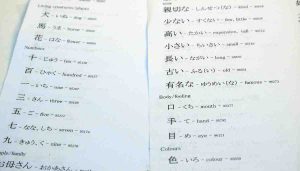What is N4?
Overview
This exam tests your knowledge of grammar, vocabulary, about 300 kanji, hiragana and katakana pertinent to daily communication skills.
Additionally you should learn grammatical constructions from books such as Minna no Nihongo Book 1 and 2.
The context on which most questions are based are everyday settings in which participants are usually friends/people whom you associate/communicate with on an equal basis in places such as at home or school, or in a library or restaurant.
All the questions are multiple choice so you choose the answer you think is correct out of three or four possibilities. There is no interview test or written test. You will pass as long as your average score from Papers 1, 2 and 3 adds up to about 55%.
It is likely you will end up with little or no time to go over what you have answered because of the sheer number of questions. Each year, the exam board brings in some grammar/words/phrases that are not part of the syllabus to keep the exam challenging.
Vocabulary – 34 questions in 30 minutes
Questions 1 and 2 include about 15 sub-questions to test if you can read kanji and if you can choose the correct nouns/adjectives in short sentences.  Question 3 examines if you can choose the appropriate noun/adjective/verb for the context given. Question 4 is to test if you can cope with some statements that are frequently employed in daily conversation. For example, they check if you know the Japanese equivalent to ‘to oversleep’ or ‘to be late for school/work’.
Question 3 examines if you can choose the appropriate noun/adjective/verb for the context given. Question 4 is to test if you can cope with some statements that are frequently employed in daily conversation. For example, they check if you know the Japanese equivalent to ‘to oversleep’ or ‘to be late for school/work’.
Listening – 28 questions in 30 minutes
Basically, as in N5, there are two types of questions. One is with visual clues and the other is without. The breakdown of these is quite similar to N5, so refer to N5 .
Question 1 and Part 2 have 15 questions in all.
With some questions you choose the picture (out of four) that best fits the answer – usually a dialogue between a man and a woman. There is a short pause between each question.
With other questions you listen to the question and choose one of the four choices given after the question. Each question is played on the tape just once.
In Parts 3 and 4 you are required to choose the best response out of three in various situations. For example, what would you say to your teacher if you had bought a souvenior for him/her? Or what would you say to your friend who volunteered to buy some fruit juice for you?
The majority of dialogues are set in places such as a house, museum, post office, restaurant, shop school or taxi. In some questions you hear only one person describing a topic such as the weather forecast or the announcement as to when the next boat leaves from the port.
A lot of students find this part the most difficult because they have not been exposed to hearing Japanese in daily life.
It is also hard to concentrate on the tape questions that come one after another for 30 minutes. You have no time to think twice as to which option to choose. An instant response is required to be able to keep up with the tape.
Grammar and reading comprehension – 35 questions in 60 minutes
There are questions about 1. particles 2. adverbs such as ‘more, certainly,continuously’ 3. giving and receiving related verbs 4. constructing grammatically correct sentences by re-arranging the words given 5. choosing the most appropriate word out of four to complete a short passage 6. notes/emails/letters you must read in order to answer a couple of questions about them 7. some simply written notices/notes that were put on a public bulletin board
Strategies to pass the exam
As the format of all JLTP exam has changed, more emphasis has placed on what you can do with Japanese-language skills.
Therefore, the nature of the listening tests has changed slightly. For example, they now test if you can respond sensibly to suggestions/questions/offers. This did not exist in previous exam formats. So you need to practise listening to this new style of questions.
However, to prepare not only for the listening but also for the vocabulary and reading/grammar, the best method is to communicate with Japanese people interatively on a regular basis.
Having said that, a solid grammar foundation is always an asset, with a wide range of vocabulary including kanji. I suggest you aim to have at least one strength to compensate for any weak areas.
